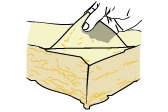
Many different materials can be used for insulation, including rock wool, glass wool, sheep’s wool, cellulose, polystyrene and straw bales, among others. Find out how they compare in terms of performance and cost.
There are many ways to skin a cat, and almost as many ways to keep heat from entering or escaping your home. Different materials offer different things – some are easier to install in certain circumstances, some are better for retrofits, some simply perform far better than others and some have added soundproofing benefits that may tip the scales in their favour.
See how different insulation materials compare, and find out what suits your needs best.





